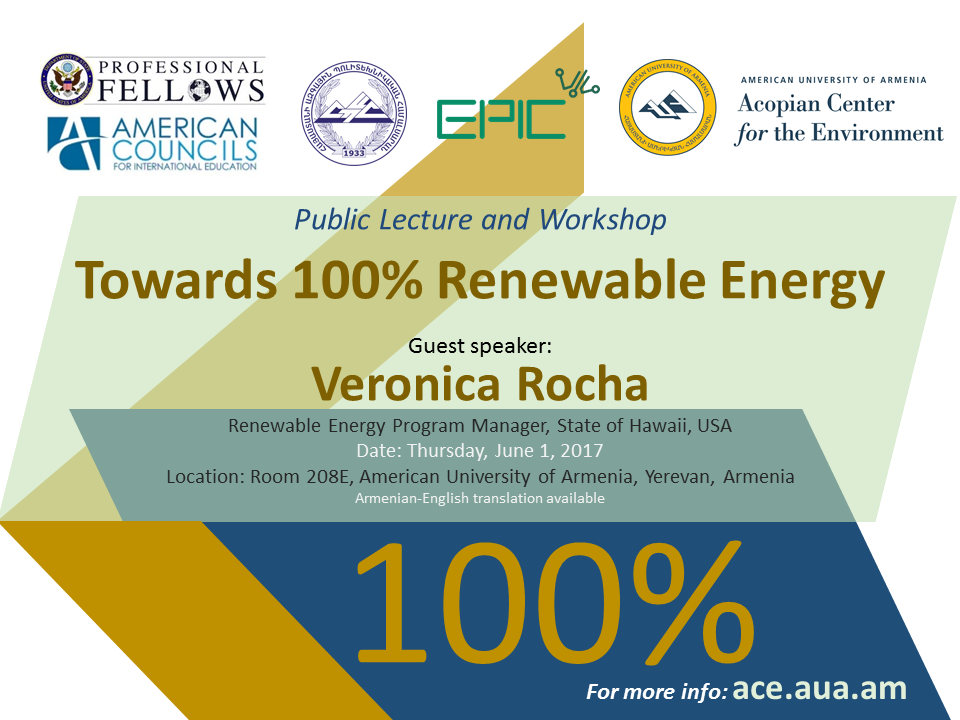
Guest speaker: Veronica Rocha, Renewable Energy Program Manager, State of Hawaii, USA
Date: Thursday, June 1, 2017
Location: Room 208E, American University of Armenia, Yerevan, Armenia
Armenian-English translation available
Description
The U.S. State of Hawaii has set a goal of 100% renewable electricity generation by the year 2045. Our speaker, Ms. Veronica Rocha, is responsible to lead her government office to achieve this goal. The speaker will present her experiences and on-going challenges towards meeting such an ambitious target, the role of innovators and entrepreneurs, and the possibility of adopting similar ambitious approaches in Armenia.
The lecture will be followed by a workshop where the participants will be divided into two groups, one group will be discussing the role of entrepreneurs in achieving 100% renewable energy generation and the second group will brainstorm on the opportunities and challenges in setting a similar target in Armenia.
The event is jointly organized by the AUA Acopian Center for the Environment, AUA Entrepreneurship and Product Innovation Center (EPIC), National Polytechnic University of Armenia (NPUA), and the U.S. Department of States’ Professional Fellows Program (PFP) alumna within the “Renewable Energy is the key to Energy independence and economic development” project, which aims to exchange knowledge on energy sector policies, strategies, projects and initiatives.
The participants will also become familiar with new engineering programs that AUA and NPUA will launch in Fall 2017 on the topic of renewable energy, resource management, and sustainable development.
For more info visit http://acenew.aua.am or call +374-60-612520.
Event Agenda
| 09:30-10:00 | Registration |
| 10:00-10:15 | Opening Remarks: Alen Amirkhanian, AUA Acopian Center for the Environment Aram Gevorgyan, National Polytechnic University of Armenia Nune Sakanyan, PFP alumna |
| 10:15-11:00 | Towards 100% Renewable Energy, Veronica Rocha, Keynote Speaker |
| 11:00-11:15 | Coffee break |
| 11:15-12:30 | Workshop Group A: Role of entrepreneurs in achieving 100% renewable energy Group B: Challenges/opportunities for 100% renewable energy in Armenia |
| 12:30-13:00 | Group presentations and discussion |
| 13:00-13:30 | OPTIONAL TOUR OF AUA CAMPUS (EPIC labs and solar-energy facilities) |

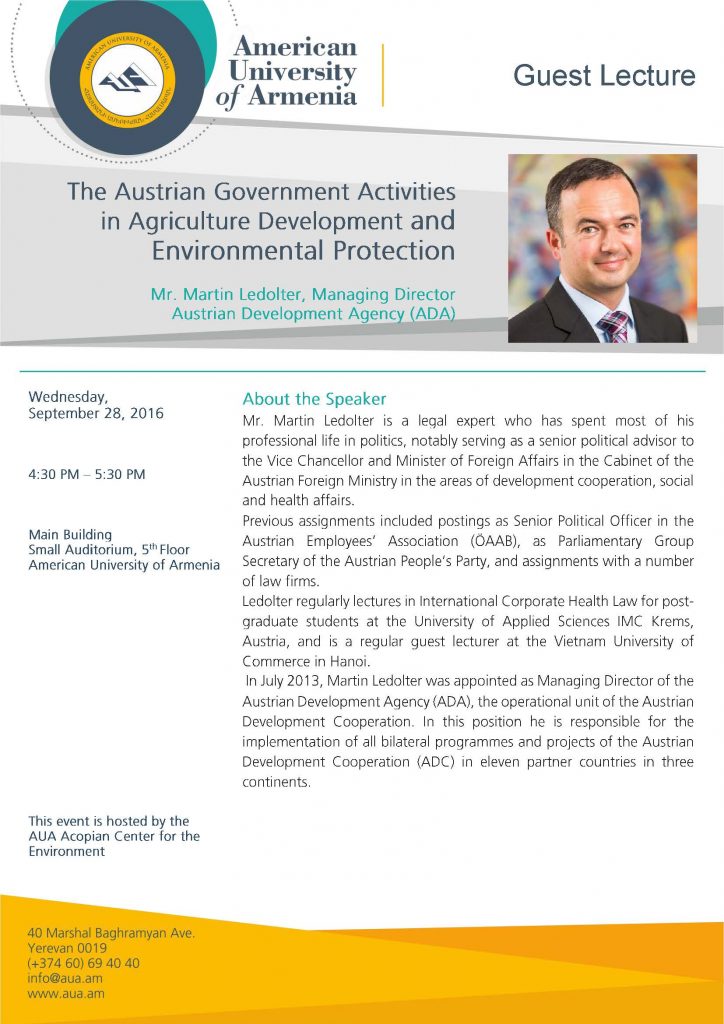
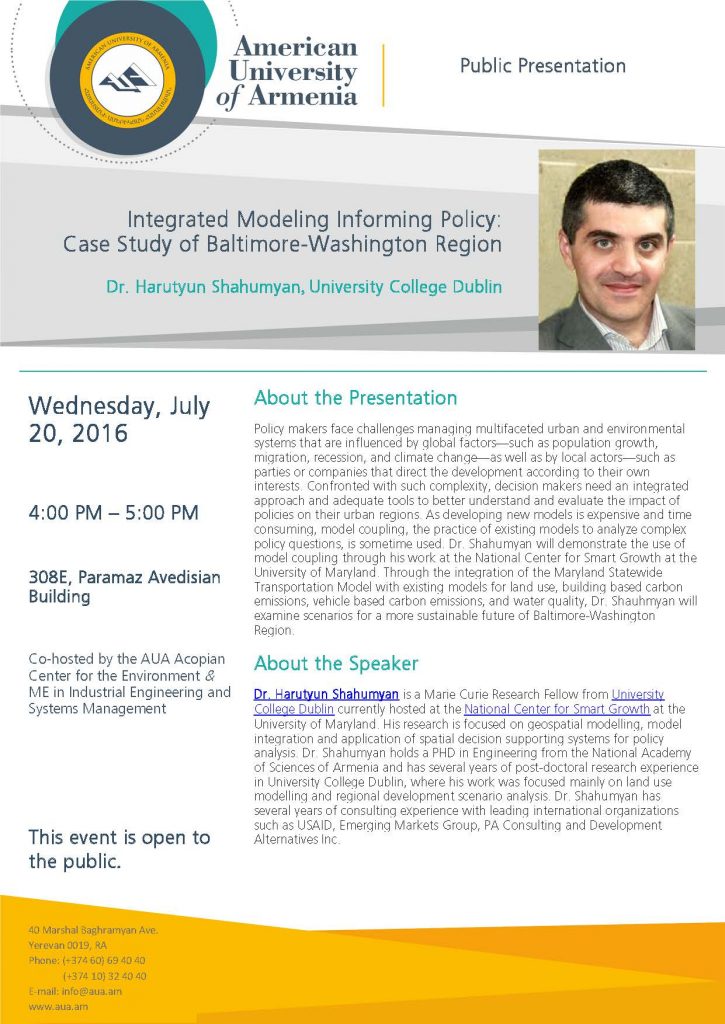

Instructor: Arthur Dolmajian
Class Schedule: MWF, 18:00 – 21:00, May 23 – June 10
Pre-requisites: None
NOTE: This course satisfies the AUA graduate degree environmental requirement
Course Description: The course aims to introduce and develop introductory and intermediate skills in application of Geographic Information Systems (GIS) to visualize, analyse, and interpret relationships, patterns, and trends in the fields of environmental and public health as well as sustainable agriculture and transportation. GIS as a tool, however, is applicable to a wide variety of fields and industries, including marketing, logistics, urban development, and so on.
Forty (40) seats available. Open to AUA and non-AUA community:

80 University Students Discuss Yerevan’s Sustainable Energy Action Plan (SEAP)
More than 80 students from 5 universities gathered at AUA to discuss Yerevan’s Sustainable Energy Action Plan (SEAP), which identifies ways in which the municipality can reduce its energy use and carbon emissions by 20% by the year 2020. Input from students was used in the final draft of the Yerevan SEAP, which has been approved by Yerevan Municipality’s Council of Elders and submitted to the EU Covenant of Mayors. Yerevan is one of the 13 Armenian cities joining the Covenant of Mayors and one of the 7 in Armenia to have submitted its SEAP. Leading the development of the Yerevan SEAP was our adjunct faculty member, Ms. Astghine Pasoyan, in her capacity as the founder and director of the Foundation to Save Energy. Preparation of the Yerevan SEAP was funded by the United Nations Development Programme in Armenia.
80 ուսանողներ մտքեր փոխանակեցին Երևանի «Կայուն էներգետիկ զարգացման գործողությունների ծրագրի» շուրջ (ԿԷԶԳԾ)
Հինգ համալսարաններ ներկայացնող ավելի քան 80 ուսանողներ հավաքվել էին Հայաստանի ամերիկյան համալսարանում (ՀԱՀ)՝ քննարկելու Երևանի «Կայուն էներգետիկ զարգացման գործողությունների ծրագիրը», որը սահմանում է այն ուղիները, որոնց միջոցով քաղաքապետարանը կկարողանա 20 տոկոսով կրճատել էներգիայի սպառումը և ածխածնի արտանետումները 2020թ-ի դրությամբ։ Ուսանողների մտքերը հաշվի են առնվել Երևանի ԿԵԶԳԾ-ում, որը հաստատվել է քաղաքի ավագանու կողմից և ներկայացվել է ԵՄ Քաղաքապետերի դաշնագրին։ Երևանը Հայաստանի այն 13 քաղաքներից է, որոնք միացել էն կլիմայի և էներգիայի վերաբերյալ ԵՄ Քաղաքապետերի դաշնագրին և այն 7 հայկական քաղաքներից մեկն է, որն արդեն ներկայացրել է իր ԿԵԶԳԾ-ն։ Երևանի ԿԵԶԳԾ-ի մշակման աշխատանքները ղեկավարում էր «Էներգախնայողության աջակցման հիմնադրամի» (ESF-Հայաստան) հիմնադիր տնօրեն, մեր գործընկեր Աստղինե Պասոյանը։ Երևանի ԿԵԶԳԾ-ի պատրաստման աշխատանքները ֆինանսավորվել են ՄԱԿ-ի զարգացման ծրագրի հայաստանյան գրասենյակի կողմից։

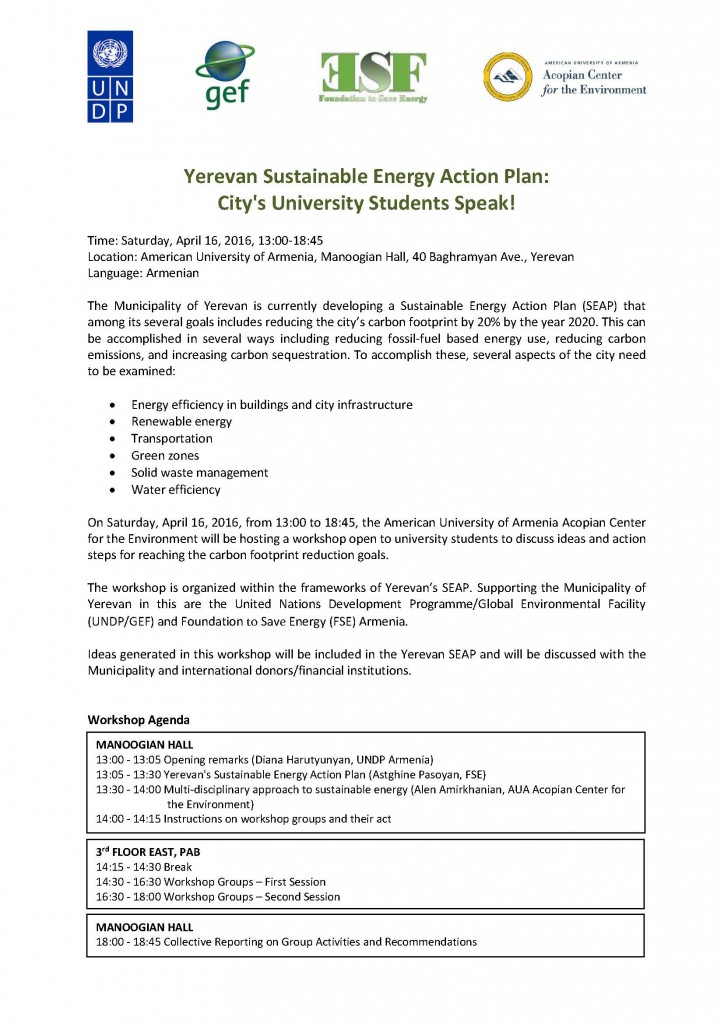
NOTE: This course satisfies the AUA graduate degree environmental requirement
Course Description: The course aims to introduce and develop introductory and intermediate skills in application of Geographic Information Systems (GIS) to visualize, analyze, and interpret relationships, patterns and trends in the fields of environmental management, public health, sustainable agriculture and transportation. GIS as a tool, however, is applicable to a wide variety of fields and industries, including marketing, logistics, urban development, and so on. Students will also learn to use Global Positioning System (GPS) units to collect spatial data.
Course Description: The course aims to provide a basic understanding of land-use mapping with remote-sensing techniques. The focus will be on multispectral remote sensing and pixel based image classification. For land use mapping, freely available satellite data from the Landsat mission will be used. Processing will be done with ArcMap10 or similar software.
For more information about the course and registration please contact us by phoning at 060 61 25 20 or 060 61 26 38 or visit AUA Registrar’s office.

WASTEnet: A BLACK SEA NETWORK PROMOTING THE INTEGRATED NATURAL WASTEWATER TREATMENT SYSTEMS
July 2, 2014
Venue: Manoogian Hall, American University of Armenia, Yerevan, Armenia
Time |
|
10:30 – 11:00 | Registration |
11:00 – 11:10 | Welcome Remarks, Alen AMIRKHANIAN, AUA Acopian Center for the Environment, Armenia |
Opening remarks, Menelaos CHATZIAPOSTOLIDIS, DEYAK | |
Opening Remarks, John BARKER, EU Delegation in Armenia | |
11:10 – 11:30 | Overview of Black Sea Cross Border Cooperation Projects in Armenia, Amalia HOVSEPYAN, Ministry of Economy of Armenia |
11:30 – 11:50 | The WASTEnet Project and its Contribution to the Black Sea Regional Development, Prof. Georgios SYLAIOS, Democritus University of Thrace, Greece |
11:50 – 12:10 | Current Status of Wastewater Treatment in Armenia, Representative of the Ministry of Nature Protection of Armenia (TBD) |
12:10 – 12:30 | Local Solutions to Wastewater Problems — Hovhannes GHAZARYAN, UNDP Armenia |
12:30 – 13:30 | Lunch |
13:30 – 13:50 | Current Status of Natural Treatment Systems and Potentials in their Implementation in Armenia – Parakar case — Arevik HOVSEPYAN, Global Water Partnership, Armenia, Samvel VARDANYAN, Parakar village mayor, Armenia |
13:50 – 14:10 | The Legislative Framework and Present Status on Wastewater Treatment in the Black Sea Basin — Prof. Ketevan KUPATADZE, Ilia State University, Georgia |
14:10 – 14:30
| Wastewater Treatment through NTS: Minimizing Pollution in an Eco-friendly manner — Prof. Vassilios TSIHRINTZIS, Democritus University of Thrace, Greece |
14:30 – 14:50 | Natural Treatment Systems: Types and Applications of the Constructed Wetlands Technology — Dr Irini KOTTI, Democritus University of Thrace, Greece, Prof. Georgios SYLAIOS, Democritus University of Thrace, Greece |
14:50 – 15:10 | Design parameters and Efficiency of household small-scale plants — Prof. Georgios GIKAS, Democritus University of Thrace, Greece |
15:10 – 15:30 | Natural treatment Systems in Turkey: benefits, costs and operational problems — Prof. Sibel BASAKCILARDAN–KABAKCI, Yalova University, Turkey |
15:30 – 15:50 | Coffee Break |
15:50 – 16:10 | Protecting the Natural Wetlands of Danube River Basin — Dr. Jenica HANGANU, Dr. Adrian CONSTANTINESCU, Danube Delta National Institute, Romania |
16:10 – 17:10 | Discussion on the role of the civil society in the promotion of NTS in the BSB — Olga KOVALIOVA, Eco-TIRAS, Moldova; Alen AMIRKHANIAN, AUA Acopian Center for the Environment, Armenia; Prof. Georgios SYLAIOS, Democritus University of Thrace, Greece |
17:10 – 17:30 | Workshop Summary, Prof. Georgios SYLAIOS, Democritus University of Thrace, Greece |
Կեղտաջրերի բնական ինտեգրված մաքրման համակարգեր խրախուսող սևծովյան ցանց՝ WASTEnet
2014թ. հուլիսի 2
Անցկացման վայր՝ Մանուգեան դահլիճ, Հայաստանի ամերիկյան համալսարան
Ժամ |
|
10:30 – 11:00 | Մասնակիցների գրանցում |
11:05 – 11:10 | Բացման խոսք, Ալեն Ամիրխանյան, ՀԱՀ Յակոբեան բնապահպանական կենտրոն, Հայաստան |
Բացման խոսք, Մենելաոս Խացիապոստոլիդիս, ԴԵՅԱԿ | |
Բացման խոսք, Ջոն Բարքեր, Հայաստանում ԵՄ պատվիրակություն | |
11:10 – 11:30 | Հայաստանում սևծովյան անդրսահմանային համագործակցության ծրագրերի ակնարկ, Ամալյա Հովսեփյան, ՀՀ էկոնոմիկայի նախարարություն |
11:30 – 11:50 | WASTEnet ծրագիրը և դրա նպաստը սևծովյան տարածաշրջանային զարգացմանը, պրոֆ. Գեորգիոս Սիլայոս, Թրակիայի Դեմոկրիտեսի համալսարան, Հունաստան |
11:50 – 12:10 | Կեղտաջրերի մաքրման ներկա մակարդակը Հայաստանում, ՀՀ Բնապահպանության նախարարության ներկայացուցիչ |
12:10 – 12:30 | Տեղական լուծումներ կեղտաջրերի հետ կապված խնդիրների համար, Հովհաննես Ղազարյան, ՄԱԿ-ի Զարգացման ծրագիր, Հայաստան |
12:30 – 13:30 | Ճաշ |
13:30 – 13:50 | Հայաստանում կենսաբանական մաքրման մեթոդների ներկա վիճակը և դրանց իրականացման ներուժը` Փարաքարի օրինակը, Արևիկ Հովսեփյան, Գլոբալ ջրային համագործակցություն, Հայաստան, Սամվել Վարդանյան, Փարաքարի գյուղապետ, Հայաստան |
13:50 – 14:10 | Կեղտաջրերի մաքրման իրավական շրջանակը և ներկա վիճակը Սև ծովի ավազանում, պրոֆ. Քեթևան Քուփաթաձե, Իլիայի պետական համալսարան, Վրաստան |
14:10 – 14:30
| Կեղտաջրերի մաքրումը ԲՄՀ միջոցով՝ աղտոտման նվազեցում էկոլոգիապես մաքուր մեթոդներով, պրոֆ. Վասսիլիոս Ծիհրինձիս, Թրակիայի Դեմոկրիտեսի համալսարան, Հունաստան |
14:30 – 14:50 | Բնական մաքրման համակարգեր՝ կենսաբանական լճակների տեխնոլոգիայի տեսակները և կիրառումը, դոկ. Իրինի Կոտտի, Թրակիայի Դեմոկրիտեսի համալսարան, Հունաստան, պրոֆ. Գեորգիոս Սիլայոս, Թրակիայի Դեմոկրիտեսի համալսարան, Հունաստան |
14:50 – 15:10 | Տնային փոքր կայանների նախագծման պարամետրերը և արդյունավետությունը, պրոֆ. Գեորգիոս Գիկաս, Թրակիայի Դեմոկրիտեսի համալսարան, Հունաստան |
15:10 – 15:30 | Բնական մաքրման համակարգերը Թուրքիայում՝ օգուտները, ծախսերը և շահագործման խնդիրները, պրոֆ. Սիբել Բասակչիլարդան-Քաբաքչի, Յալովայի համալսարան, Թուրքիա |
15:30 – 15:50 | Սուրճի ընդմիջում |
15:50 – 16:10 | Դանուբ գետի ավազանի բնական ճահճուտների պահպանումը, դոկ. Յենիցա Հանգանու, դոկ. Ադրիան Կոնստանտինեսկու, Հետազոտությունների և զարգացման Դանուբ դելտա ազգային ինստիտուտ, Ռումինիա |
16:10 – 17:10 | ՍԾԱ-ում ԲՄՀ տարածման գործում քաղաքացիական հասարակության դերի քննարկում, Օլգա Կովալյովա, Էկո-ՏԻՐԱՍ գետերի պահապանների միջազգային ասոցիացիա, Մոլդովա, Ալեն Ամիրխանյան, ՀԱՀ Յակոբեան բնապահպանական կենտրոն, պրոֆ. Գեորգիոս Սիլայոս, Թրակիայի Դեմոկրիտեսի համալսարան, Հունաստան |
17:10 – 17:30 | Սեմինարի ամփոփում, պրոֆ. Գեորգիոս Սիլայոս, Թրակիայի Դեմոկրիտեսի համալսարան, Հունաստան |
Date: February 20, 2014
Event Type: Seminar, Public Discussion
Speakers: See program
Venue: American University of Armenia
The AUA Acopian Center for the Environment in partnership with Organization for Security and Cooperation in Europe (OSCE) and Norsk Energi, the Norwegian consultancy leading a technical assistance to the small hydro-power sector in Armenia, organized a public event reviewing the results of a two-year project called “Sustainable Hydro-Power Development for Energy Security.” The project was grant funded by the Norwegian Foreign Ministry to strengthen the small hydro-power sector while improving its environmental performance in Armenia. The outputs of the project’s working group are publicly available at www.smallhydroarmenia.org. In attendance at the event were more than 60 representatives of civil society, OSCE-supported Aarhus Centers, Armenian government, private industry, and the diplomatic corps.
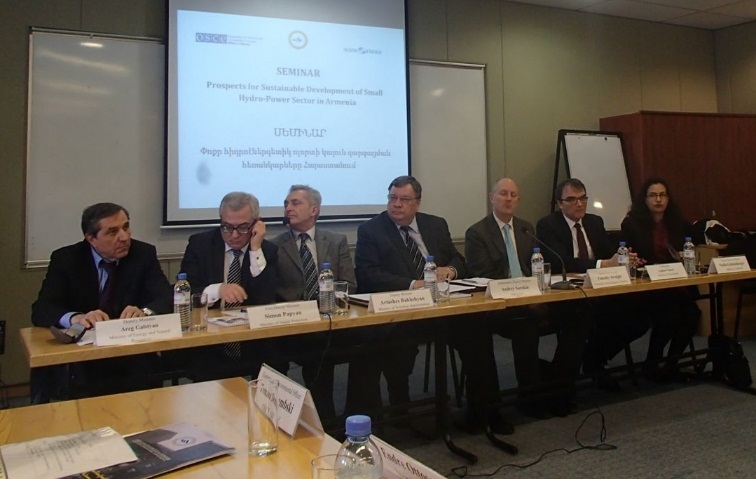
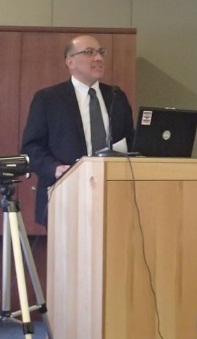
Dr. Bruce Boghosian welcoming participants to the public event on small hydropower plants
Date: February 13, 2014
Event Type: Seminar
Speaker: Tigran Parvanyan, International Finance Corporation
Venue: American University of Armenia
Tigran Parvanyan, IFC, at a seminar co-sponsored by the AUA College of Science and Engineering and the Acopian Center for the Environment. Mr. Parvanyan spoke about small hydro power technologies used in Armenia and issues related to managing risks with these power plants.
Date: January 27, 2014
Event Type: Public Discussion
Speakers: Alen Amirkhanian, Simon Papyan, Azganush Drnoyan, Artur Grigoryan, Adrianan Jordanova
Venue: American University of Armenia
The American University of Armenia’s Acopian Center for the Environment (AUA ACE), in cooperation with the Republic of Armenia’s Ministry of Nature Protection and the World Bank, organized a public discussion on the country’s Draft Law on Environmental Impact Assessments (EIA).
The Republic of Armenia is currently considering a Draft Law on Environmental Impact Assessment that promises to offer advances in the way environmental impact assessments are done for mining, construction, agriculture, urban planning, and other projects. The legislation also intends to bring the national legislation in compliance with Armenia’s international legal obligations, including the Espoo and Aarhus Conventions as well as the Kyiv Protocol.
First Deputy Minister of Nature Protection Mr. Simon Papyan, who led the working group that drafted the law, presented the aims and the status of the current draft. Two members of this working group, Ms. Azganush Drnoyan and Mr. Artur Grigoryan, also presented on the details and innovations of the current draft legislation. In addition, the World Bank’s Lead Environmental Specialist, Ms. Adriana J. Damianova, presented her view on ways in which the current draft will address some of the concerns about the approval of mining projects.
A major advance in the current draft is that it empowers public authorities to define the scope of work for EIAs. This is in sharp contrast to the current law, in which the applicant proposes a scope and authorities have no legal basis to demand otherwise. The draft law also introduces new approaches to the valuation of environmental harm resulting from economic activity. It also paves paths for more effective public participation and determination of affected communities.
Present in the audience were more than 60 environmental experts, representatives of international development organizations, environmental NGOs, and the concerned public. A key message emerging from the in-depth discussion was that the draft law, in spite of its strides, still has gaps that need to be addressed.
Mr. Papyan encouraged the concerned public to present their comments in writing for consideration. He and other experts in the audience explained that there is still time to amend the Draft Law even if it has already been presented to the National Assembly’s Standing Committee on Agriculture and Environment.
The current Draft Law was proposed after Republic of Armenia President Serzh Sargsyan vetoed an earlier version in 2012 citing that “the standards for assessment of the impact of economic activities is not adequately substantiated.”[1] Many environmentalists also opposed the vetoed version.
No concrete timetable exists on when the current Draft Law will be adopted by the National Assembly for final approval and sent to the President for signature. It is, however, widely anticipated that the National Assembly will act on the Draft Law in its Spring session.
AUA President Dr. Bruce M. Boghosian and AUA ACE Director Alen Amirkhanian welcomed the participants in their opening remarks. “It is my hope that AUA can become a space to discuss environmental issues openly and rigorously. For this, we need government, business, international organizations, and civil society to come together and exchange ideas and views. This will only strengthen our ability as a country to develop sound approaches and policies,” said Amirkhanian.
Video recording of the event is available here.
To download individual speaker’s texts, presentations, and videos, please click here.
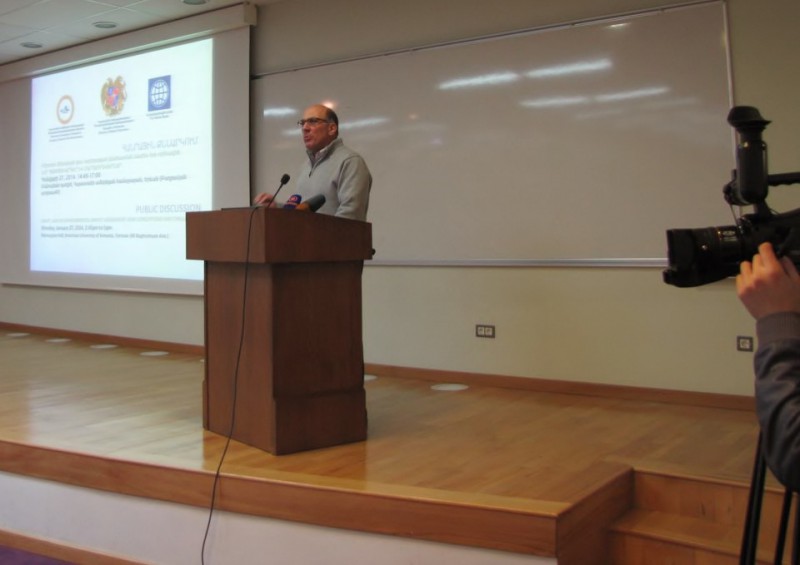
AUA President Dr. Bruce M. Boghosian offers his welcoming remarks.
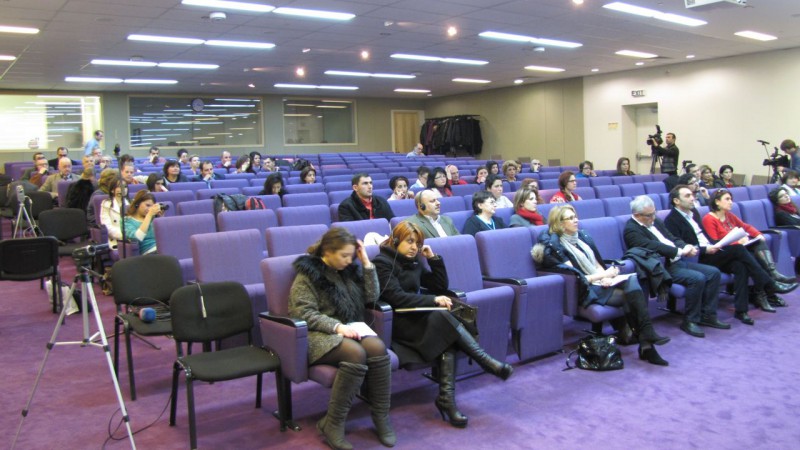
Environmental experts, representatives of international development organizations, environmental NGOs, and members of the concerned public were present at the event.
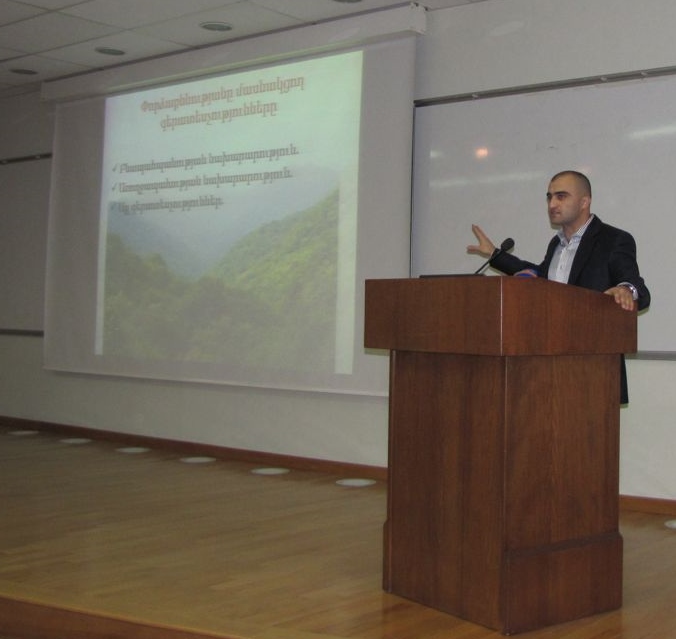
Artur Grigoryan, Member of the working group for developing the Draft EIA law.

From left to right: Artur Grigoryan, Azganush Drnoyan, Adriana Jordanova Damianova, and Simon Papyan.

Adriana Jordanova Damianova, Lead Environmental Specialist and Program Team Leader in Europe and Central Asia Region, the Sustainable Development Department, The World Bank
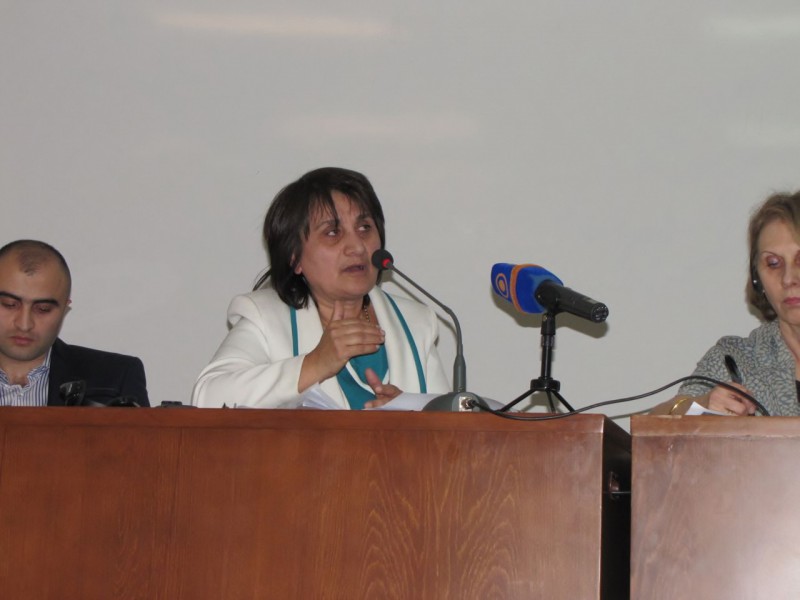
Azganush Drnoyan, Expert of the Environmental Expertise, member of working group for developing the Draft EIA law

Alen Amirkhanian, Director of the AUA Acopian Center for the Environment
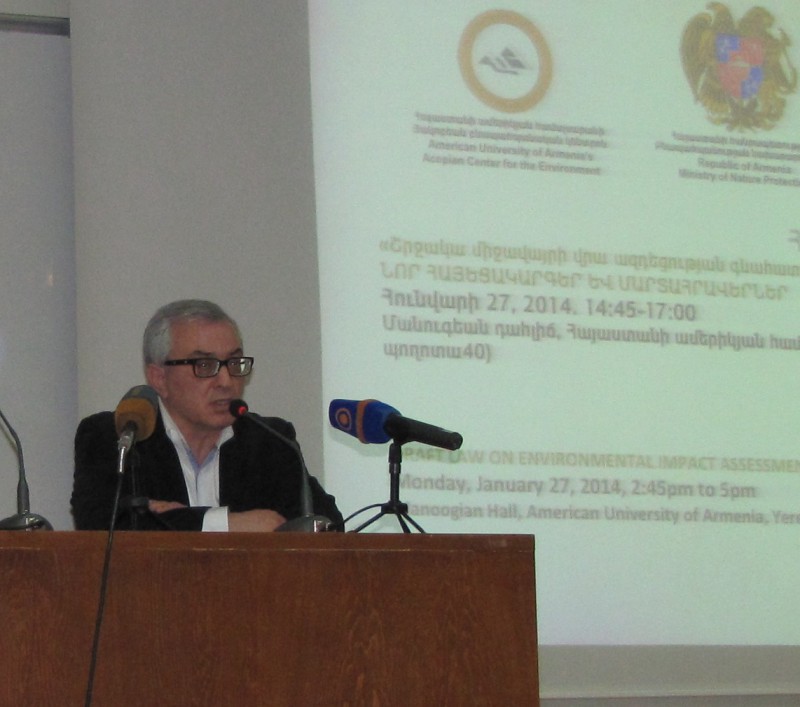
First Deputy Minister of Nature Protection Simon Papyan discusses the Draft Law on EIA.
[1]www.unece.org/fileadmin/DAM/env/pp/compliance/MoP4decisions/Armenia/toARM_IV9a_CC37.pdf
American University of Armenia (AUA) in cooperation with Renewable Resources and Energy Efficiency Fund (R2E2) hosted the Second International Steering Committee Meeting within the frame of BSBEEP Project in Yerevan. The Partners discussed the work that has been done and the work which needs to be finalized. During the meeting the project website was presented by R2E2 and project logo was decided from three available designs offered by Samsun Metropolitan Municipality.
During the meeting a public-media event was organized promoting energy efficiency in buildings and highlighting EU’s role in this. Presenters included:
The public-media Event’s main aim was to raise the awareness of public and to engage interested establishments.
Media Coverage:
ArmNews – http://www.armnewstv.am/1386575490
Hajastani Hanrapetutyun – http://www.hhpress.am/index.php?sub=hodv&hodv=20131210_7&flag=am
Armenia TV– http://www.armeniatv.am/hy/news/44642
A1+ – http://www.a1plus.am/am/economy/2013/12/09/energy;
http://www.youtube.com/watch?v=MGdfZ0ezYms;
Tert.am– http://www.tert.am/am/news/2013/12/09/energakhayutyun/
http://www.tert.am/am/news/2013/12/09/energy/
CivilNet– http://civilnet.am/2013/12/09/green-news-energy-efficiency-crediting/
Date: November 21, 2013
Event Type: Pubic Discussion
Speakers: Alen Amirkhanian, Armine Ishkanian, Levon Abrahamyan, Hranush Kharatyan, Jenny Paturyan
Venue: American University of Armenia
Dr. Ishkhanian discussed the findings in her published academic report based on extensive research conducted from 2011 to 2013 on the rise of environmental activism in Armenia. The report particularly focused on civil society campaigns against mining in the country. Through an examination of recent activism in Armenia (2007-present), Ishkhanian highlighted the achievements as well as the challenges and obstacles facing civil society in Armenia. The objective of this report was to contribute to on-going debates within Armenia and its Diaspora about mining in the country as well as the wider socio-economic and political developments in Armenia. Ishkhanian’s presentation on her findings was followed by presentations and discussions by eminent Armenian scholars and researchers:
Professor Levon Abrahamian, corresponding member of the National Academy of Sciences of the Republic of Armenia (NAS RA) and the Head of the Department of Contemporary Anthropological Studies, Institute of Archaeology and Ethnography, National Academy of Sciences of the Republic of Armenia.
Dr. Hranush Kharatyan, leading specialist, Institute of Archaeology and Ethnography, National Academy of Sciences of the Republic of Armenia.
Dr. Yevgenya Paturyan, assistant director, Turpanjian Center for Policy Analysis, American University of Armenia.
The panel discussion was chaired by Alen Amirkhanian, director, AUA Acopian Center for the Environment.

Շրջակա միջավայրը և Հայաստանի պետ-բյուտջեն
Date: July 29, 31, August 2, 2013
Event Type: Public Discussion
Speaker: Ashot Harutyunyan, Head, Department of Monitoring of Environmental Strategic Programs, RA Ministry of Nature Protection
Venue: American University of Armenia
3 սեմինարներ “Շրջակա միջավայրը և Հայաստանի պետ-բյուտջեն” թեմայով:
Three seminars entitled “The Environment and Armenia’s State Budget.” In Armenian.

Date: August 1, 2013
Event Type: Seminar
Speaker: Vitali Avagyan, AUA CSE Alum, Luys Fellow, Imperial College PhD Candidate
Venue: American University of Armenia
The seminar explored the best optimization techniques for decision making under uncertainty tailored specifically for the British electricity market with a large amount of renewable electricity sources. The aim of the seminar was to give some understanding of energy policy, models of investment and policy implications of firms’ collective behavior in the electricity market. Additionally, short-term and long-term investment models and models for energy systems were discussed.
Date: July 16-17, 2013
Event Type: Seminar
Speaker: Vicken Aprahamian, Senior Process Metallurgist, Ottawa, Canada
Venue: American University of Armenia
Vicken Aprahamian talking at AUA on Clean Smelter Technologies. The talk was co-organized by AUA Acopian Center for the Environment (AUA ACE), Foundation for Preservation of Wilderness and Cultural Assets (FPWC), and the Armenian Environmental Network (AEN)

Date: July 10, 2013
Event Type: Seminar
Speaker: Keith Bildstein, Sarkis Acopian Director of Conservation Science, Acopian Center for Conservation Learning, Hawk Mountain Sanctuary, Orwigsburg, USA
Venue: American University of Armenia
In July of 2013 we were fortunate to have in Armenia Dr. Keith Bildstein, Sarkis Acopian Director of Conservation Science, from Hawk Mountain Sanctuary in the U.S. He is among the preeminent experts in the world on raptors (“գիշատիչ թռչուններ”). He came to Armenia for research on Levant Sparrowhawks in the Meghri region. He conducted this research with Siranush Tumanyan. His talk was on the Movement Ecology of Turkey Vultures in North and South America, a topic he has studied for more than 10 years. He also talked about the research he and Siranush Tumanyan were doing in Meghri.

Date: April 27, 2013
Event Type: Workshop
Participant/Presenter: Alen Amirkhanian, Director, AUA Acopian Center for the Environment
Venue: Ayb High School
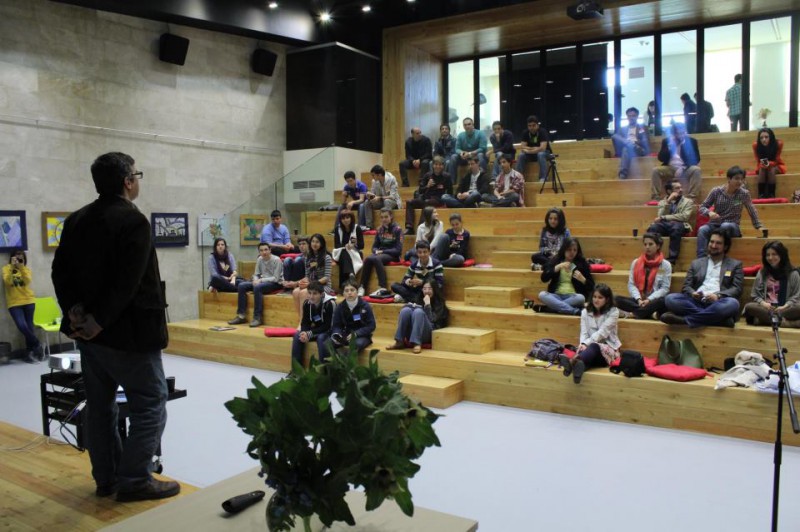
AUA Acopian Center for the Environment Director Alen Amirkhanian discusses green design at Ayb Educational Complex. Photo by Nare Sahakyan, Storaket.
 The AUA Acopian Center for the Environment joined with Storaket Architectural Studio and Ayb Educational Foundation in organizing a workshop focused on developing a green concept plan for expanding the Yerevan campus of the Ayb Educational Hub. The event brought more than thirty youth together to discuss environmentally friendly design solutions for the seven hectare expansion project currently being designed by Storaket.
The AUA Acopian Center for the Environment joined with Storaket Architectural Studio and Ayb Educational Foundation in organizing a workshop focused on developing a green concept plan for expanding the Yerevan campus of the Ayb Educational Hub. The event brought more than thirty youth together to discuss environmentally friendly design solutions for the seven hectare expansion project currently being designed by Storaket.
“It was very encouraging to see all the enthusiastic and committed young people finding green design both challenging and engaging,” said AUA ACE Director Alen Amirkhanian, who presented at the workshop frameworks and accepted practices in integrating environmentally sensitive design solutions. “Having a real project on the table gave the participants concrete problems to address.”
Amirkhanian’s talk and subsequent breakout groups focused on managing water and wastewater, solid waste, energy, transportation, and green zones.
Speaking to the participants, Ayb Principal David Sahakyan introduced the school’s guiding philosophy and long-term plans while Shant Isaianns of Storaket discussed the master plan being developed for the campus.
“The theme-specific workshops generated many ideas for consideration by the architects,” added Amirkhanian. “It was very rewarding to hear one of the participating high-school students ask, ‘can we do this again?’”
Date: April 22-23, 2013
Event Type: International Scientific Symposium
Speakers: See program
Venue: American University of Armenia
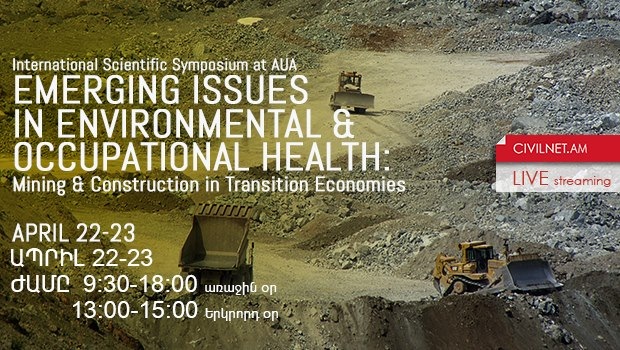
The American University of Armenia organized an international scientific symposium focused on exploring the occupational and environmental health issues around mining and construction in transition economies such as Armenia.
This symposium, titled “Emerging Issues in Environmental and Occupational Health: Mining and Construction in Transition Economies,” was organized by the AUA School of Public Health and AUA Acopian Center for the Environment in cooperation with the Collegium Ramazzini, an independent, international academy advancing the study and practice of occupational and environmental health and safety.
“We hope to engage a broad spectrum of occupational and environmental health scientists working in academia, as well as government and non-government organizations, business, labor, and other organizations in the public and private sectors,” explained Varduhi Petrosyan, associate dean of the AUA School of Public Health. “The symposium seeks to improve the understanding of how evidence-based scientific findings can be applied to strategically protect workers’ and community health in the region.”
The conference takes place at a time of new challenges facing many transitional economies, particularly in the post-soviet sphere. Armenia, along with other former communist-block states, has been unable to develop adequate responses to the socio-economic, environmental, and public health concerns rising from unregulated market growth in mineral extraction and construction
“The research presented provided solutions to the many occupational and environmental health problems facing the communities and laborers affected by these industries,” says Alen Amirkhanian, director of the AUA Acopian Center for the Environment. “Our goal is to move the discussion forward and help craft public policy that can address these issues, protect workers and ensure we properly develop these industries.”
The language of the conference was English with simultaneous translation into Armenian. The conference was streamed live online at http://civilnet.am For more information, visit http://eoh2013.aua.am
Videos:
Event Type: Seminar
Speaker: Andrei Guschin, Advisory Council Member, Climate Solutions, Seattle, USA; Visiting Professor, American University of Armenia
Venue: American University of Armenia

Clean technology entrepreneur Dr. Andrei Guschin spoke at the American University of Armenia on the use of algae to remove mining runoff toxins such as Selenium. The public seminar was a part of an ongoing series organized by the AUA Acopian Center for the Environment.
Selenium (Se) is a naturally occurring element found in trace levels in soils, water, plants and animals. The anthropogenic redistribution of Se through agricultural runoff, coal combustion, refining of metal ores and mining has caused elevated levels of selenium that is harmful to plants and animals.
Algae have been identified as agents that can remove Se and other pollutants from contaminated water, as they have the ability to accumulate into their organism heavy metals and other toxins. If algal bioremediation is to be effective, the production of large quantities of biomass is required. During the growth of microalgae, metals and other toxins are removed from the environment by adsorption.
By providing the proper growth conditions, such as light, pH, temperature etc., algae biomass can provide a simple, cost effective method of bioremediation. Dr. Guschin discussed the process of bioremediation with algae in greater detail as well as technology created at Bionavitas, a company he had co-founded, which has applications to facilities using the sun by reducing the effects of self-shading. This enables smaller footprint solutions.
About the Speaker:
Based in Seattle, USA, Dr. Andrei Guschin is a lecturer in Entrepreneurship & Innovation at AUA and other leading business schools in Eastern Europe and North America. He has been educating entrepreneurs on how to build successful companies since 2004. He has served as Chair of the Venture Lab, a division of the Massachusetts Institute of Technology (MIT) Enterprise Forum NW.
In addition, Dr. Guschin co-founded two clean technology companies, including Bionavitas, Inc., where he was Director, R&D, responsible for developing a platform technology to dramatically increase algal growth for remediation of mining runoff. Dr. Guschin also consulted with Fortune 500 firms in strategy development, and advised 3M in selecting products for mass production. He was a postdoctoral associate at MIT with a Nobel Laureate and holds a Ph.D. from the Russian Academy of Sciences and an M.S. from the Moscow Institute of Physics and Technology. He also studied at the Ross School of Business, University of Michigan.
Date: March 27, 2013
Event Type: Seminar
Speaker: Ani Haykuni, Manager, Forestry Services at the Armenian Tree Project Charitable Foundation
Venue: American University of Armenia
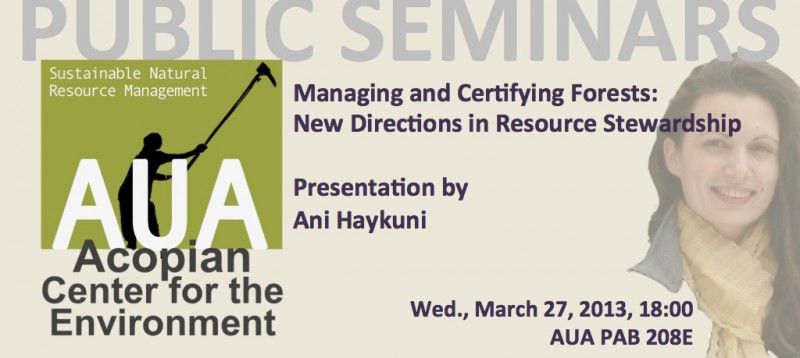
The AUA Acopian Center for the Environment hosted a public lecture on the topic of forest management. The presentation was delivered by Ani Haykuni, the manager of Forestry Services at the Armenian Tree Project (ATP) Charitable Foundation.
Forests are among the most important parts of earth’s ecosystem. They affect the planet’s carbon and hydrological cycles, house a vast concentration of its species biodiversity, and more than 14 million people are directly employed in forest-related industries.
As a resource, forests need to be managed both for long-term human security as well as the sustainability of the planet. Haykuni outlined the role of public policy as well as highlighted relatively new mechanisms, such as forest certification, for their sound management. She wconcluded by discussing the close nexus between forests, people, and community development.
About the Speaker:
Ani Haykuni works as a Manager of Forestry Services for ATP Charitable Foundation (Armenia Tree Project). She is a Muskie 2009 alumnus, and holds an MPS degree in Forest and Natural Resources Management and Policy from State University of New York’s College of Environmental Science and Forestry. She also holds an MA in Forestry Engineering from Armenian State Agrarian University. She is recipient of several awards including the Careers for Alumni in Public Service (CAPS) Award, Elena Gastaldo Fellowship, Jay and Olive Bentley Award, Carl M. Rise Fellowship, among others. Her current areas of interest are forest and natural resources management, policy and law, community forestry/community development, forest certification, gender equality and women’s empowerment.
Date: March 20-22, 2013
Event Type: Workshop
Participant: Karen Aghababyan, Chief Scientist, AUA Acopian Center for the Environment
Venue: Barcelona, Spain
The European Breeding Bird Atlas 2 (EBBA2) Workshop took place in Barcelona, Spain. Attending the Workshop from the AUA Acopian Center for the Environment was Dr. Karen Aghababyan, the Center’s Chief Scientist and Head of Environmental Lab. Dr. Aghababyan has recently been appointed by the European Bird Census Council as Armenia’s National Coordinator of its EBBA2 initiative.
The Workshop was dedicated to launching the preparation for the new Atlas. The Workshop participants also discussed standardization of data and methods, management and processing, planning and fundraising, on-line portals, and engagement of local and foreign observers in the process of data collection. “This is an ambitious project and requires participation of National Coordinators from 50 or so countries,” says Dr. Aghababyan. “The EBBA2 will update the ground-breaking first version, the data of which is by now 30 years old,” he continued.
At the Workshop, Dr. Aghababyan presented the current condition of ornithological data gathering in Armenia, esp. as it relates to the Atlas. He reported that some of the data collection work has begun. Training modules for volunteers are developed and tested. Other countries that presented their efforts included Slovakia, Serbia, Czech Republic, Turkey, Russia, and Croatia.
Date: March 7, 2013
Event Type: Seminar
Speaker: Agustin Tashdjian, Intern from Argentina, Birthright/Armenian Volunteer Corps
Venue: American University of Armenia
The AUA Acopian Center for the Environment hosted a public seminar on the environmental impact of mineral extraction and processing in Armenia. The presentation explored the process of ore extraction and refinement for copper, gold and molybdenum and was delivered by Mr. Agustin Tashdjian, a Birthright/Armenian Volunteer Corps intern from Argentina.
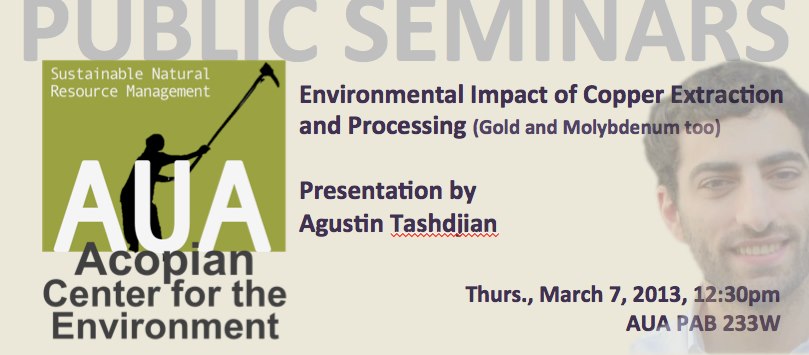
During his presentation, Mr. Tashdjian also discussed the environmental risks associated with these practices. He concluded by focusing on some of the risk-management and pollution-prevention measures used in copper mining and point out mitigation measures that are applicable to the mining of gold and molybdenum.
Over the past decade, environmental concerns over metal mining in Armenia have become more vocal.
The environmental impact of mining goes far beyond the scarring of the landscape. The process of extraction and the tailing dumps created can pollute the air, soil, and water for a very long period. Such pollution often also poses risks to the livelihood of communities living in the proximity of these mining sites.
For the past two months, Tashdjian has been working at the AUA Acopian Center for the Environment under the supervision of Dr. Karen Aghababyan. He has been conducting an extensive literature review on ore extraction and processing, especially for copper, gold, and molybdenum.
Mr. Tashdjian is currently studying for his Master’s in chemistry at the Buenos Aires University. In addition to his studies, he is working at the Electrochemistry Research Lab under the tutelage of Professor Graciela A. Gonzalez. Tashdjian’s main area of interest is environmental chemistry, an area he will pursue further in his PhD studies.
Date: February 12, 2013
Event Type: Seminar
Speaker: Vahe Kharazyan, Head, Instrumentation and Control Department, Yerevan Combined Cycle Power Plant (Yerevan JEK)
Venue: American University of Armenia
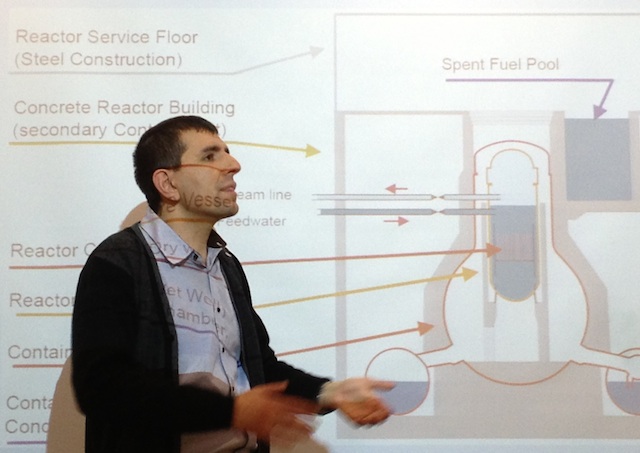
A seminar exploring the nuclear disasters at Chernobyl, Fukushima and Three-Mile Island was organized by the College of Science and Engineering and the AUA Acopian Center for the Environment. It reviewed the sequence of critical events leading up to the accidents at each plant, the countermeasures taken, their effectiveness, and the consequences of the public’s exposure to radiation.
“Armenia generates 40% of its electricity using nuclear power, a share that is expected to remain if not grow with the construction of a proposed new nuclear power plant,” said Alen Amirkhanian, Interim Director of the AUA Acopian Center for the Environment. “At AUA, we see it as a responsibility to engage our students and the community at large to discuss both the advantages and risks of such an energy source.”
The seminar was led Dr. Vahe Kharazyan, head of the Instrumentation and Control Department at the Yerevan Combined Cycle Power Plant (Yerevan JEK).
Kharazyan, who has been working in Armenia’s energy industry for more than five years as an engineer and consultant, briefly discussed the technologies employed in Chernobyl, Fukushima, and Three-Mile Island nuclear power plants.
For each of these catastrophic accidents, Dr. Kharazyan explained the series of events that led to disasters. In the case of Three-Mile Island and particularly Chernobyl, design shortcomings were severely complicated by operator and management errors.
In case of Fukushima, operator error did not play a part. The walls built to act as tsunami barriers were 5.7 meters tall whereas the actual tsunami waves that hit the plant on March 11, 2011 were 14 meters tall. The force of the waves knocked the backup system out of operation.
Kharazyan concluded the seminar by highlighting some of the policy changes that were made or are likely to be made in response to these nuclear disasters.
Dr. Kharazyan received his PhD in Cogeneration from the Energy Research Institute of Armenia and an MS degree in Science and Technology Policy from the University of Minnesota.
He has been actively involved with the PA Consulting Group in the preparation for the environmental impact assessment of the new nuclear power plant proposed for Armenia. Dr. Kharazyan is also a regular guest lecturer at the AUA course IE352 (Decision Making Tools for Energy).
Date: November 30, 2012
Event Type: International Scientific Symposium
Speakers: Saleem Ali and 12 national and international experts
Venue: American University of Armenia
(http://newsroom.aua.am/2012/12/05/mining-socio-economic-development-media/)
International and local experts were in Yerevan on for a one-day conference examining the choices available to Armenia as it tries to balance economic gains with that of social equity as well as public and environmental health.
The conference featured a keynote presentation on mining’s role in economic growth and social development by Dr. Saleem Ali, Director of the Centre for Social Responsibility in Mining at the University of Queensland, Australia. The event’s first panel examined whether mining can play a key role in Armenia’s economic growth, while the second panel focused on mining’s impact on Armenia’s environmental and public health. The event’s last panel explored whether Armenia’s legal and institutional framework on mining fosters socio-economic development.
These issues were discussed against the larger backdrop of a growing unease in and outside Armenia on the potential benefits and risks of mining to the country’s socio-economic and environmental future.
Dr. Saleem Ali and Dr. Varduhi Petrosian speak to Civilnet about mining and its economic, environmental and health impacts in Armenia
PANEL 1: Can mining play a key role in Armenia’s economic growth? (video)
Moderator: Alen Amirkhanian, College of Science and Engineering, AUAPanelists:
PANEL 2: Mining and Armenia’s Environmental and Public Health: Impact and Mitigation (video)
Moderator: Karen Aghababyan, Acopian Center for the Environment, AUAPanelists:
PANEL 3: RA Legal and Institutional Framework on Mining: Does it foster Armenia’s socio-economic development?(video)
Moderator: Tom Samuelian, Dean, College of Humanities and Social Science, AUAPanelists:
Closing Remarks: Outlining Key Takeaways and Future To Do’s (Dr. Saleem Ali) (video)

Date: November 28, 2012
Event Type: Seminar
Speaker: Artak Hambarian, Associate Director, College of Science and Engineering, American University of Armenia
Venue: American University of Armenia
More than 20 architecture and engineering students and professionals received certificates for completing a course on Solar Architecture organized by the “Improving Energy Efficiency in Buildings” project of the UNDP’s Global Environment Facility and the American University of Armenia.
Conducted in the summer of 2012, the course engaged young professionals and students in an intensive, one-week seminar on passive and active energy design features for buildings. Participants gained insight into a number of environmentally efficient design principals and strategies.

The concepts explored during the program ranged from passive methods that focused on the extensive use of natural ventilation, daylight maximization and nighttime cooling to increase energy efficiency, as well as active methods to generate and conserve energy through solar panels, solar thermal panels, integrated PV piping, hybrid systems, and solar paint.
The certificates were awarded by UNDP Communications Associate Hovhannes Sarajyan, UNDP/GEF “Improving Energy Efficiency in Buildings” Project Task Leader Vahram Jalalyan and the Deputy Director of Architecture Research Center, Professor Artak Hambaryan.
Date: November 9, 2012
Event Type: Seminar
Speaker: Lief Erickson, Deputy Chief, USAID Project Providing Support to Armenia’s Energy Sector
Venue: American University of Armenia
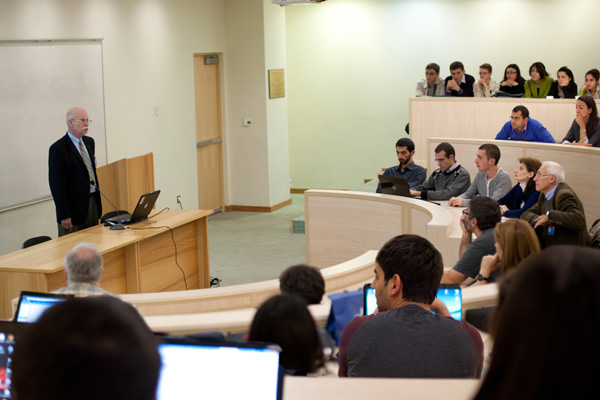
AUA’s College of Science and Engineering organized a seminar focusing on the environmental impact assessment of Armenia’s new nuclear power plant, featuring Mr. Lief Erickson, the Deputy Chief of the USAID project providing support to Armenia’s energy sector.
More than 60 students, faculty and guests attended the seminar led by Mr. Erickson, who has been working with the Government of Armenia since 2007. Among Mr. Erickson’s tasks have been supporting the development of an Environmental Impact Assessment on the proposed nuclear plant.
During his presentation, Mr. Erickson described the process of building a new nuclear plant required by RoA laws and International conventions and summarized the status of the EIA done by CJSC “METSAMORENRGOATOM”, the joint Russian-Armenian company formed as the project’s developer and eventual operator.
The proposed 1000 MW power plant is estimated to cost USD 5 Billion and would require 10 years for design and construction. The design phase alone is expected to cost USD 400 to 500 million, an amount the Government of Armenia is working to secure.
Date: October 25-26, 2012
Event Type: Networking Event
Venue: American University of Armenia
AUA faculty and researches joined colleagues from Armenia and Sweden for an international seminar at Yerevan State University focused on building cooperation between Swedish and Armenian universities.
The two day Swedish-Armenian Contact Seminar brought together more than 60 Armenian and 30 Swedish academics and researches to exchange experiences and seek mutual areas of interest that could lead to collaboration in research and technology development.
The event was organized by the International Programme Office for Education and Training, a Swedish government agency, and the National Tempus Office in Armenia.
AUA faculty attended from the Colleges of Science and Engineering, Humanities and Social Sciences, Business and Economics, and Public Health as well as researchers from the AUA Acopian Center for the Environment represented AUA and its range of research interests.
Date: October 2012
Event Type: Workshop
Participant: Alen Amirkhanian, Director, AUA Acopian Center for the Environment
Venue: Karlsruhe, Germany
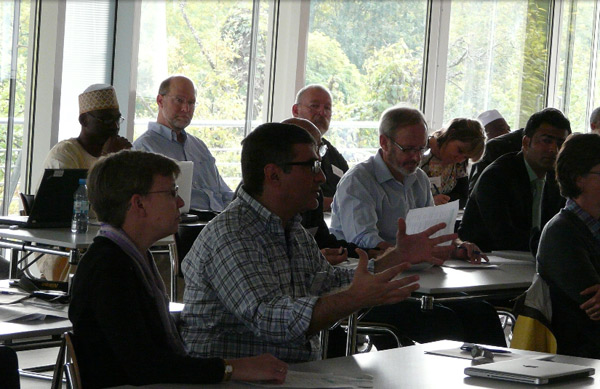
The American University of Armenia participated in an annual get-together of educators from around the world to discuss environmental and sustainability topics in the education sector.
The International Greening Education Event (IGEE), held in Karlsruhe, Germany, provided participants a global platform to share ideas, experiences and knowledge.
”AUA’s participation in the event comes as our faculty continue to work toward deepening and enhancing the university’s environmental curriculum,” said Alen Amirkhanian who represented AUA at IGEE. “Understanding and protecting the natural environment is a cross-disciplinary endeavor. We want to make sure that the AUA curriculum reflects this.”
Date: May 3, 2012
Event Type: Seminar
Speakers: Margrit von Braun, Ronald Dobbin, Susan Spalinger
Venue: American University of Armenia
The American University of Armenia’s College of Health Sciences and Acopian Center for the Environment organized a Seminar on Lessons Learned from Hazardous Waste Sites from Around the World and a Panel Discussion on the Role of Safety, Health, and Communities in Mining and Metals.
Dr. Margrit von Braun presented case studies from waste sites in the US, Russia, Nigeria, Dominican Republic and other locations around the world. The sites – focused on mining and metals recycling – were used to describe the frequent intersections of human rights abuses, pollution and poverty and the importance of understanding environmental pathways as well as the key roles of environmental scientists, community leaders, non-governmental organizations, governmental officials, policy makers and others in resolving environmental problems.
Dr. von Braun briefly presented the main environmental regulations of the US and covered the history of their development. Ronald Dobbin continued the presentation covering health problems of those who work in mining and metal recycling industries (reproductive problems related to lead exposure, cancer and other lung problems related to exposure to diesel emissions, asbestos, and crystalline silica dust). Susan Spalinger concluded the panel discussion presenting the role of communities in environmental clean-ups and importance of proper risk communication.
AUA students, researchers, faculty, representatives of health and environmental NGOs, and environmental activists attended the two meetings and had active discussions with the experts.
Dr. von Braun is Dean/Professor Emerita of the College of Graduate Studies at the University of Idaho and a founder of TerraGraphics International Foundation, a non-profit corporation that assists community leaders, local governments, universities, and other NGOs to apply accepted environmental health intervention and remediation methodologies in low and middle income countries. She is the Founder and Vice President of TerraGraphics Environmental Engineering, Inc., an Idaho-based U.S. consulting engineering company with more than 100 employees and offices in four States. Ronald Dobbin is an Occupational Hygienist who worked in the U.S. federal public health agencies for over 30 years and is the President of the Society for Occupational and Environmental Health in the U.S. Susan Spalinger is a Principal Environmental Scientist and Human Health Risk Assessor at TerraGraphics Environmental Engineering Inc., U.S.
 | 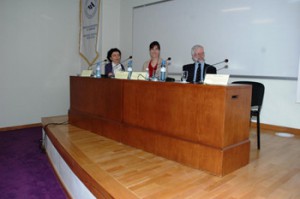 |  |
| Dr. Margrit von Braun | Varduhi Petrosyan, Susan Spalinger, and Ronald (Denny) Dobbin | Audience |
Date: September 2011
Event type: International Conference
Speakers: See program
Venue: American University of Armenia
The AUA Acopian Center for the Environment became a co-organizer of the International Conference “Biological Diversity and Conservation Problems of the Fauna of the Caucasus” participated by more than 150 conservationists and scientists from 9 countries. Results of the Conference are published in the Proceedings Book.
At the Conference Acopian Center for the Environment has presented 5 articles on various aspects of study on Birds and Butterflies.
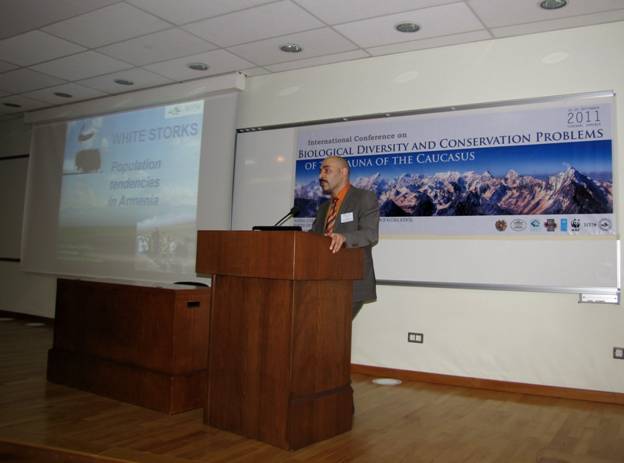

Archive
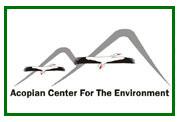 | Date: December 16, 2008 Event Type: Conference Venue: American University of Armenia |  |
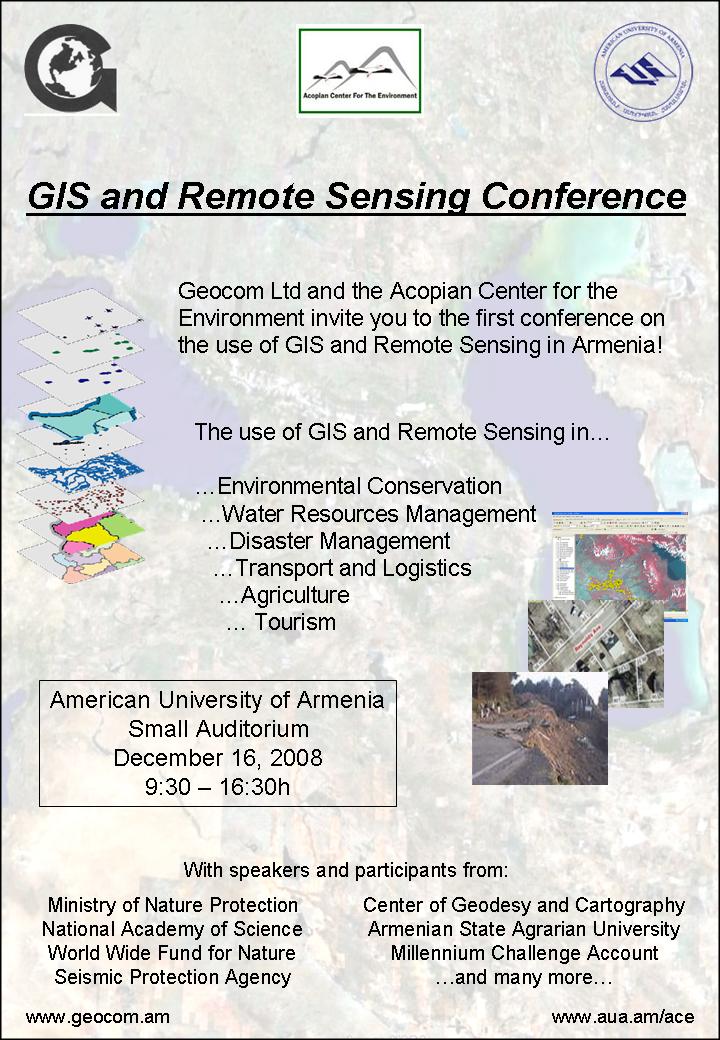 Acopian Center for the Environment
Acopian Center for the Environment
GIS Solutions for State and Private Enterprises- Geocom Ltd
The first conference on the use of GIS and Remote Sensing in Armenia was a big success. Geographic Information Systems (GIS) are highly sophisticated computer programs which are used to analyze and store spatial data, produce maps, and make prognoses. They are being applied in a wide range of sectors and are state-of-the-art technology used worldwide. The conference was jointly organized by the AUA Acopian Center for the Environment and Geocom Ltc. It attracted more than 40 participants from private GIS companies, state agencies, universities, major NGOs and international organizations. The presentations covered a wide range of important subjects, such as the use of GIS in the field of forest management, disaster management, water and waste water management, and geochemical pollution monitoring. It was the first time that GIS stakeholders from Armenia met over such an event and it was a great opportunity for improved cooperation among institutions working in the same field. All participants agreed that the conference shall be repeated in the following years.
Participating organizations:
| ACDI/VOCA |
| Armenia Tree Project |
| Armenian Agricultural Academy – Forestry Department |
| Armenian Society for the Protection of Birds |
| Armenian Water and Sewerage Company (AWSC) |
| AUA (AmericanUniversity of Armenia) |
| Center for Ecological Noosphere Studies of National Academy of Sciences (Ecocenter) |
| Environmental Impact Monitoring Center (EIMC) |
| Forest Monitoring Center |
| German Embassy |
| German Technical Cooperation – GTZ |
| Locator Ltd |
| Millenium Challenge Account |
| Ministry of Nature Protection – Department of Protected Area Management |
| National Academy of Science |
| OSCE |
| Seismic Protection Agency |
| UNDP |
| WWF Caucasus (World Wide Fund For Nature) |
| YSU (Yerevan State University) |
Conference
2006
Environmental Conservation and Research Center-Renee Richer
WWF Armenia -Karen Manvelyan,
Armenia Tree Project-Jeff Masarjian
Armenian Forests NGO– Jeffrey Tufenkian
EcoArmenia forum-NGOs

In 2006 the ECRC at the AmericanUniversity of Armenia, along with its EcoArmenia partners, started a company regarding a proposed new highway that would run through the middle of the Shikahogh Forest Reserve in southern Armenia, which is the unique habitat for variety of endangered flora and fauna.
In late 2004, the Ministry of Transport and Communication of the Republic of Armenia has approved the project on construction of the Kapan-Meghri motorway in order to promote trucking and passenger transportation between Armenia and Iran. This road was intended to serve an alternative to, then, the only route Kapan-Kajaran-Meghri which runs through the highest in Armenia mountain pass and is unsafe to drivers, especially during the winter. According to the initial draft, 17 km of the motorway had to stretch right through Shikahogh Reserve what would inevitably lead to annihilation of this protected area.
In May 2005, the coalition “SOS Shikahogh” was established to join professional ecologists and laymen from over 40 national and international non-governmental organizations (NGO) and scientific bodies. The coalition was initiated by WWF, ATP, ArmenianForest and ECRC (AUA), and later was joined by a number of local NGOs.
Activities of the “SOS Shikahogh” coalition were supported by numerous protest rallies, publications and TV broadcasts.
Part of the company was helding a public forum at AUA, where participants from the government, non-governmental organizations, and civil society discussed and debated the environmental issues involved in this project. The outcome was that the highway was rerouted around the reserve in order to protect the forest and the communities of plants and animals that live there.
The outcome of these serious actions was that on 29 June 2005 the Government of the Republic of Armenia has made a decision on road construction in detour of the reserve and not through it. However, the sceptical forecasts of professionals turned out a reality: located mostly on the northern slopes of the Meghri Ridge and being very serpentine, this motorway is not popular among drivers, especially the Iranian truckers.